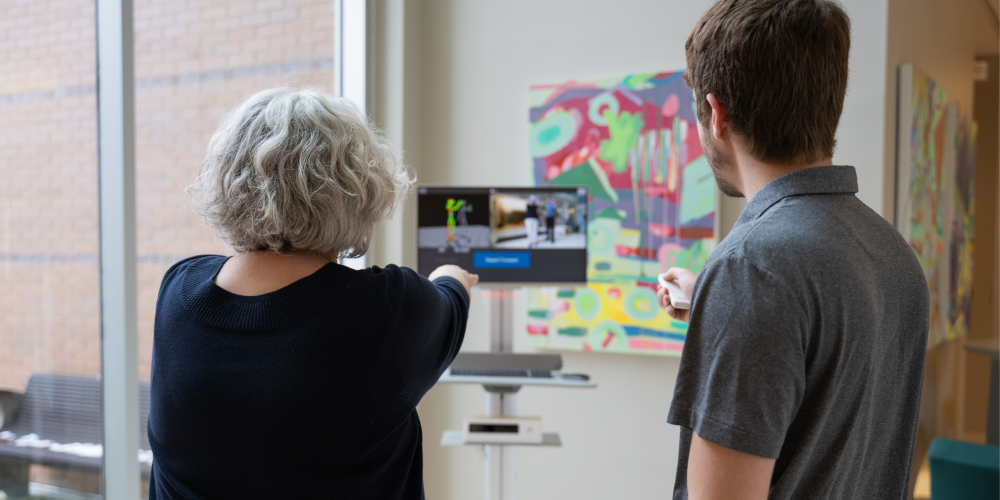Originally published October 2022. Updated August 2024.
The advent of AI technology in healthcare has sparked diverse reactions among therapists. Some embrace it wholeheartedly, while others are more cautious. But what exactly do therapists think about VirtuSense’s fall-risk assessment solution, VSTBalance?
An Industry Veteran's Perspective: The Impact of AI on Fall Prevention
In a reflective interview, Kari Brizendine, PT, CWS, CDP, CADDCT, CMDCP, and Education Specialist at Select Rehab, shared her insights after nearly four decades in the physical therapy field.
“I’ve been in the field for 38 years, and I’ve been through many changes. But I think the change with AI as it relates to fall reduction has been groundbreaking,” she says.
She emphasizes the shift from reactive to proactive care. In the past, interventions occurred only after a fall, but now, with AI-driven solutions like VSTBalance, therapists can identify potential risks early and quickly intervene.
Harnessing AI for Proactive Care
Brizendine further highlights the role VSTBalance plays in speeding up evaluation and diagnosis.
“[With VSTBalance], we’re able to use machine vision to see things we might miss with the naked eye. While therapists have expert knowledge in things like gait analysis and balance evaluation, we now have a way to capture problems much more quickly and act upon them more thoroughly.”
Addressing Concerns: Will AI Replace Therapists?
The introduction of AI technology often raises concerns about job security. Some therapists fear that AI might reduce the need for their expertise. However, Brizendine dispels these fears.
“VSTBalance will never replace therapist positions. [The system] is an adjunct to what they are taught to do...[results from VSTBalance are] a piece of the entire picture when you’re looking at an evaluation or assessment,” Brizendine assures.
The reality is that VSTBalance enhances, rather than diminishes, the role of therapists. Simply put, the technology couldn’t exist without the therapists who perform the assessments. The system streamlines data that therapists can use to develop more effective care plans, allowing them to focus on the holistic well-being of their patients. It's the therapist that makes the data that VSTBalance provides useful and impactful to patients. Only they can look at the patient holistically.
AI in Memory Care: Overcoming Initial Doubts
What about VSTBalance in memory care? Initially, Brizendine had reservations about using the VSTBalance with dementia patients. However, her perspective changed as she witnessed its effectiveness in memory-care settings, noting that the use of AI for prevention in memory care is possible with some creative thinking (e.g., placing something meaningful on the VSTBalance keyboard tray to encourage dementia residents to perform a gait assessment). The ability to obtain accurate information quickly is crucial in memory care, where attention spans are shorter. VSTBalance excels in this area, with assessments taking less than two minutes.
Brizendine particularly enjoys seeing the smiles on residents’ faces during training sessions. They have fun — and they enjoy watching their peers perform assessments. The engaging nature of the tool makes residents more comfortable and willing to participate.
Related Read: 65% Increased Therapy Attendance with VSTBalance
The Precision and Power of VSTBalance
When asked about the most valuable aspect of VSTBalance, Brizendine emphasizes its specificity. responds,
“[VSTBalance] shows what the resident is doing in inches and centimeters and time. That’s not something I can do in a two-minute session. VSTBalance brings out so many details so quickly that I can use that data along with my evaluation and come up with a very specific treatment plan that’s going to help the individual improve much more quickly. And stay improved for a longer period of time," Brizendine explains.
Another key advantage of VSTBalance is its ability to offer comparative data. Therapists can easily see how the individual they’re working with compares to peers their age, a valuable insight that isn't always readily available.
Embracing AI to Enhance Not Replace, Therapists
Brizendine concludes the interview with a powerful message for her fellow therapists: “AI doesn’t replace you. It helps you to have even better outcomes with your clients. This is the time in your career when you’ve been given a chance to be proactive — rather than reactive — to fall management. That puts you in a position to be a much more effective therapist with outcomes you have not attained in the past.”
Watch how Sedgebook, a senior care community, has benefitted from the use of VSTBalance:
Request a demo of VSTBalance here.


